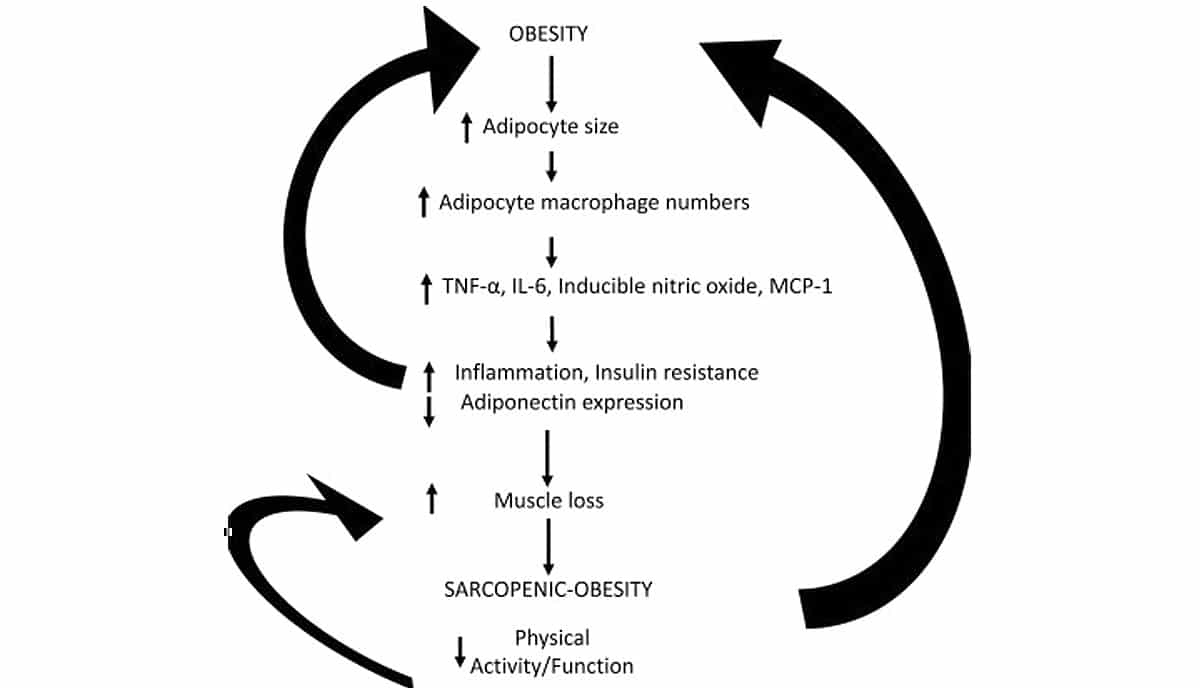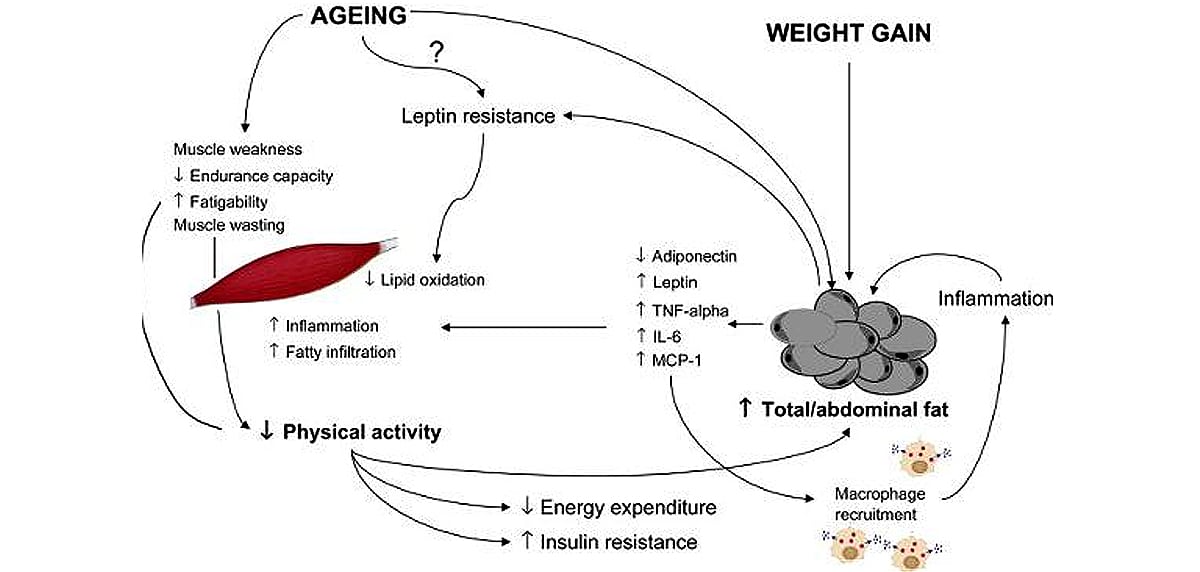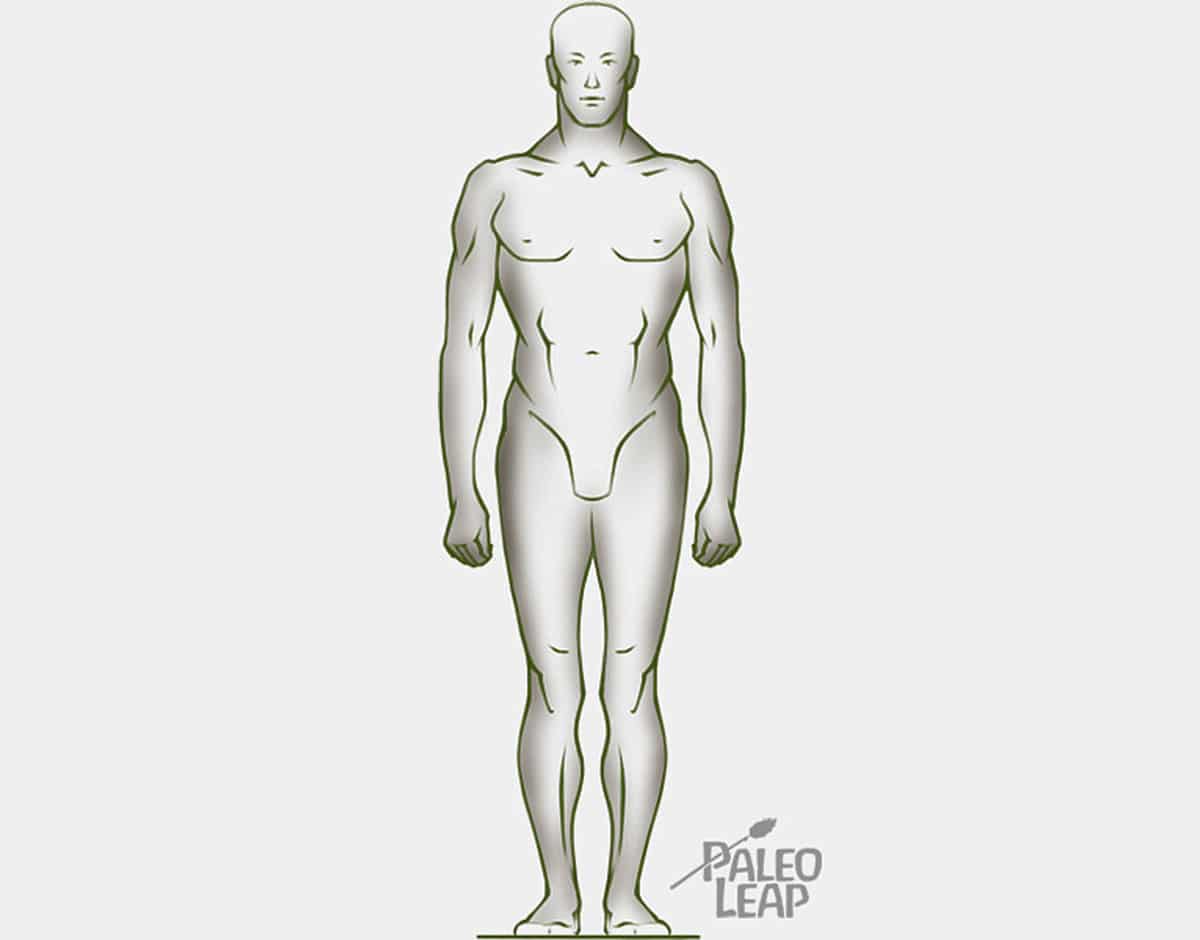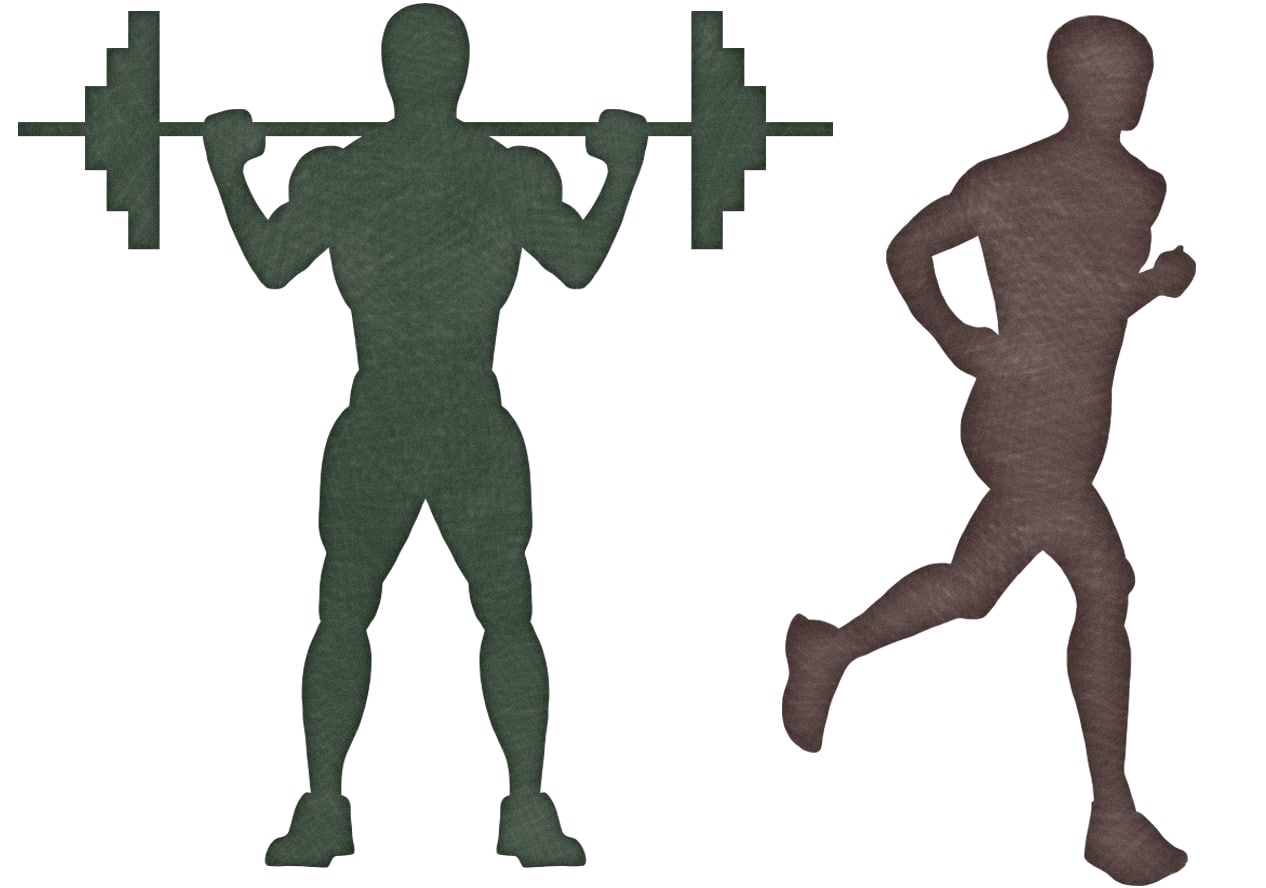From the very beginning of the ancestral health movement, Paleo-inspired exercise plans have focused on strength training over cardio, with the rationale that lifting heavy weights effectively builds and maintains muscle mass, while jogging for hours actually destroys it. But this begs the question: what’s so special about muscle mass? Why would you want to have more of it?
The first obvious answer is “because it looks good:” especially for men, but increasingly also for women, the athletic look is in. Muscles make for a nice beach body, and they’re also attractive as an outer sign of positive personal qualities like self-control, discipline, and drive.
On top of their aesthetic appeal, muscles are useful. Even in a society saturated with every form of mechanical convenience we can dream up, we still occasionally have to move a couch, push a car, or carry a bike up a flight of stairs.
But most importantly, muscles play a vital role in supporting overall health and wellness, especially into old age. They aren’t just about looking good (although that’s a nice bonus), and they aren’t just about the occasional need to help your friends move; they’re a critical factor in metabolic health, body weight control, bone strength, and resilience to stress and disease.
Muscles Promote Insulin Sensitivity
One of the most important functions of muscles in metabolic health is their ability to store glucose (carbohydrates) as glycogen. They then use this stored glycogen as fuel every time you need to move. Muscle mass essentially acts as a glycogen reserve that you top up by eating carbohydrates, and deplete when you exercise.
This makes muscle a critical player in an overall healthy metabolism, because it allows you to use carbohydrate calories for what you want (energy and activity), and not what you want to avoid (storage as fat). In more scientific terms, it increases insulin sensitivity and protects against insulin resistance. In helping your body use carbohydrates this way, muscle mass is ultimately protective against metabolic syndrome and diabetes, which are really just diseases of inadequate carbohydrate metabolism (for more on this, see the full explanation here).
On the flip side of this, sarcopenia (the technical term for inadequate muscle mass or quality) is strongly associated with diabetes. So far studies have only established a correlation, not a causation, but the strength of the relationship is telling. One group of researchers studied 810 subjects in Korea, and divided them into two groups: diabetics and non-diabetics. 15.7% of the diabetics, but only 6.9% of the non-diabetics, were sarcopenic. And in American subjects, another group of researchers found a strong correlation between sarcopenia and impaired glucose metabolism independent of body fat. In other words, the less muscle you have, the more likely you are to develop insulin resistance, metabolic syndrome, and ultimately diabetes.
Muscles Protect Against Obesity
Diabetes, of course, usually comes along with an unwelcome co-morbidity: obesity. Diabetes and obesity are really just two sides of the same coin – diabetes is the inability to use carbohydrates productively, and obesity is the natural result when your body stores them as fat instead. Both are inflammatory; both are mediated by imbalances in the gut flora; both are closely connected to autoimmunity. Unsurprisingly, the muscle wasting of sarcopenia is also strongly associated with obesity, and the two problems react on each other in a vicious cycle.
This diagram (taken from this study) perfectly illustrates the vicious cycle of sarcopenic obesity:

To explain the relationship very simply, obesity is inflammatory, and inflammation causes muscle breakdown throughout the whole body. Muscle loss makes it harder to move around, contributing to a sedentary lifestyle. Sitting all day accelerates weight gain and muscle loss, and the cycle continues.
Sarcopenic Obesity and Aging
The dangerous consequences of muscle loss and fat gain most obvious among the elderly, making muscle health especially important after middle age. Aging presents a perfect storm that greatly accelerates the rate of sarcopenia. As people get older, they generally stop exercising (if they ever did), and spend more time sitting still. But muscle, unfortunately, is a use-it-or-lose-it kind of tissue. For one thing, it takes a lot of energy to maintain, so if you want to keep it around, you have to use it regularly to show your body that it’s still worth the effort. Since an elderly person’s body already has enough to do without maintaining muscles for no reason, it breaks down the muscle proteins to spare energy and keep the heart and other organs functioning.
The elderly also don’t metabolize protein as efficiently as the young, so their protein requirements for maintaining muscle mass are higher at the time in their life when their actual protein intake is most likely to drop.
The result is a steady decrease in muscle size that really takes off around age 50 and accelerates with time. And it’s not only the amount of muscle tissue that’s affected; muscle quality also declines. Scans of elderly people’s muscles reveal much more intramuscular fat, or fat tissue that has penetrated into the muscle. Basically, the elderly are at a much greater risk of being “skinny-fat:” they aren’t noticeably underweight or under-muscled to the naked eye, but look a little closer and that “muscle mass” isn’t all muscle.
This diagram (from this study) summarizes the relationship between aging, weight gain, and muscle loss:

As you can see, it’s essentially an even more dangerous version of the sarcopenia/obesity cycle that occurs in non-elderly people.
All of these factors make old age an enormous risk factor for losing fat and gaining muscle, and as you might expect, the vast majority of sarcopenic obese patients are over 60. The consequences are severe. Sarcopenic elderly patients are more vulnerable to falls, and less able to recover from illness or hospitalization. Add obesity, and the story gets even worse; in one study, sarcopenic obese elderly patients fared dramatically worse than sarcopenic non-obese or obese nonsarcopenic patients in a test of their ability to carry out everyday activities (for example, bathing, dressing themselves, and cleaning the house). The extreme consequences of sarcopenic obesity in the elderly really highlight the crucial importance of muscle mass for maintaining a healthy spectrum of human activity
Muscles, Diabetes, and Sarcopenic Obesity: Summing it Up
To summarize the previous three sections, muscle loss is a key player in the cycle of obesity and diabetes. Gain muscle, and you improve your metabolic function and reduce your risk of fat gain. (Although it’s not a magic bullet, it’s also worth mentioning that muscle in the resting state burns more calories than fat, so it does raise your metabolism slightly).
On the other hand, if you lose muscle, your body has a harder time maintaining a healthy weight and a normal degree of insulin sensitivity. And worse still, the cumulative effect of sarcopenia, diabetes, and obesity is far greater than the sum of their individual problems. All three of these conditions magnify each other and keep you trapped in a vicious cycle of poor health.
This all goes double if you’re over 60. The elderly, as the population most at risk for muscle loss and fat gain, are especially prone to sarcopenic obesity, and have the most to gain from taking care of their muscles. But it doesn’t just affect the retiree crowd: in people who don’t regularly exercise, muscle loss starts around age 20. Preventing insulin resistance and weight gain in middle age, and heading off sarcopenic obesity in old age, start in the gym when you’re young.
Muscles And Bone Density

Moving on from the metabolic advantages of having a healthy amount of muscle mass, strong muscles also help preserve and maintain healthy bone density. Especially for women and the elderly, bone density is important for preventing osteoporosis – and it’s not just about eating your calcium chews.
The connection might not seem obvious (how does more muscle mass make your bones stronger?), but the hidden link is in the concept of loading. The best way to build strong bones is to put them under a heavy load: lift, carry, drag, or otherwise move something with a substantial weight. And all the ways of doing this also result in stronger muscles. So it’s not the muscles themselves that make your bones stronger; it’s the exercise you use to build those muscles that also builds your bones.
Specifically, weight training with heavy weights has been proven again and again to increase bone density, even in the elderly. The literature on this subject is enormous; one comprehensive review found that the benefits of walking or light aerobics were debatable, but that strength training was both safe and effective for preventing bone density decay in older adults, especially when continued consistently for at least a year.
Just like building muscle to prevent sarcopenic obesity later in life, improving bone density through strength training is another benefit that it’s best to start working on while you’re young. If nothing else, it’s much easier to maintain a habit you already have than to take up deadlifting at 65. This review even found that exercise increased bone density in preadolescent children: as long as the exercise is done at an age-appropriate intensity, there really is no age limit on the benefits.
Muscles Improve Disease Recovery
Another health benefit of muscles is their ability to create a “safety net” of protein that your body can draw on at times of increased need. Protein is one of the most important structural components in your entire body, and muscles play a key role in regulating protein availability. They absorb protein from the diet, store it, and distribute it to the heart, liver, and other organs as needed. In the absence of dietary protein, your body will break down your muscles to keep feeding your organs.
In healthy people under normal lifestyle conditions, the intake of protein from food balances out the demands from the organs, and muscle mass is preserved. In bodybuilders, the intake of protein from food exceeds the demands from the organs, and muscle mass is increased. Under the stress of any kind of illness or injury, though, your body’s protein needs increase significantly because all your organs need more support to help them fight the stressor. Patients with severe burns, for example, can require up to 3-4 grams of protein per kilogram of bodyweight (compare that to .8-1 grams/kg in healthy people).
Diet can rarely deliver this level of protein, especially diets of the hospital food that you’re likely to be stuck with if you have such a severe injury. From an evolutionary perspective, it’s also unlikely that humans could regularly get that much protein while severely injured and unable to hunt. Fortunately, your muscles can take up the slack – if you have an adequate reserve of muscle to start with. Muscle is your body’s “safety net” against the increased protein demands of illness.
If you don’t have that safety net, you’re in trouble. For example, muscle mass is an independent predictor of survival rates for patients with all kinds of cancers, even after accounting for sex, age, and stage of cancer. Compared to patients with normal muscle mass, patients with sarcopenia find chemotherapy harder to endure. They experience symptoms of overdose at lower levels of drugs, they require more rehabilitative care, they suffer from infections and complications more frequently, and they simply die more often.
From the numerous disadvantages of people who don’t have adequate muscle mass, it’s clear that skeletal muscle is an important stockpile that the body can draw on for extra nutrients when it needs them. So building up a healthy reserve of muscle is an excellent form of health insurance just in case life happens and you find yourself in the hospital with a serious problem.
Building Healthy Muscles

After all that description of the benefits of muscle mass, it’s time to get down to the details: how can you increase the size and quality of your own muscle tissue?
First of all, it’s important to note that not everyone has to be a bodybuilder in order to get these benefits. The studies linked above, that resistance training substantially improves bone density in elderly women, weren’t turning little old ladies into she-hulks with a steady diet of whey powder and creatine. To get the benefits of healthy muscle mass, you don’t have to go anywhere above the musculature that most people find attractive (unless, of course, you want to).
That said, the nitty-gritty of building muscles is actually fairly simple. First, eat adequate protein (20-25% of calories is a good ballpark number for putting on muscle) and adequate calories. If you’re losing fat, your body can build muscle mass on a slight calorie deficit because it will just take energy from body fat to make up for what you’re not putting in your mouth. On the other hand, an extreme calorie deficit is completely counterproductive and will actually destroy muscle mass you already have, since starvation produces the same kind of muscle-wasting stress response as injury or illness. 1,200 calories a day is not enough for an adult human of any size, especially if she’s also working out.
If you aren’t losing fat, you’ll need to eat a slight surplus in order to gain muscle: you can’t build any kind of mass without raw materials over and above what your body needs just to function. The bigger your surplus, the faster you’ll put on muscle, but many people prefer the “slow and steady” route since very fast muscle gain is usually accompanied by a significant amount of fat.
On the exercise front, easily the best muscle-builder around is strength training. This can be bodyweight exercises (push-ups, pull-ups, and planks, for example), or free weight training (squats, deadlifts, and presses). This article goes into a little more detail on your strength-building options, but for beginners almost any kind of exercise program will get results so don’t spend too long agonizing over which to choose.
Of course, if it were all that simple, there wouldn’t be entire forums full of amateur bodybuilders and powerlifters eagerly debating the best timing of their post-workout meals and the most effective protein powder. There’s an infinite amount of complexity out there if you’re willing to take the time to get into it. But starting off with a solid diet and a basic strength training routine will already get you a lot further than almost everyone around you. And by the time a beginner program stops giving you results, you’ll have the background knowledge to make a more informed decision about plunging into the details.
Women and Muscles
Strength training and building strong muscles are especially important for women, who tend to have less muscle to start with, and who are also more prone to osteoporosis and bone density problems. But when it comes to building muscles, women are often skeptical. Even though the benefits are significant, they’re afraid of getting “bulky,” and shy away from heavy weights in favor of extremely light dumbbells.
CrossFit has started to make a dent in this attitude, but it’s still very prevalent, and it’s time to put it to rest: lifting weights will not make you look like a bodybuilder unless you also take massive amounts of steroids, eat thousands of calories at every meal, and devote endless hours to your biceps. Figure competitors and female bodybuilders dedicate an unbelievable amount of time and effort to looking that way; unless you’re willing to imitate their regimen, it’s not going to happen to you.
That isn’t to say that weightlifting won’t change your body. But for the vast majority of women, those changes are positive: a leaner physique, arms they love showing off in T-shirts, and toned, shapely legs. So there’s absolutely no need to fear the free weights, and plenty of reasons to embrace them.
Muscles and Human Health: Conclusion
Muscles aren’t just for bodybuilders. They’re for everyone. Human beings are physiologically designed to have a fair amount of muscle mass built through regular exercise, muscle mass that allows us to metabolize carbohydrates efficiently, recover from injury or illness, and maintain our resilience and health into old age.
As a consequence of the sedentary modern lifestyle, we’re seeing all the dangers of muscle atrophy: osteoporosis, diabetes, obesity, fragile bones, and difficulty recovering from stress. These problems are not normal, and they don’t have to be inevitable parts of life. While muscle alone isn’t a miracle cure, building healthy muscle mass and maintaining it past middle age is one way to preserve good health and prevent the diseases of the modern environment.





Leave a Reply